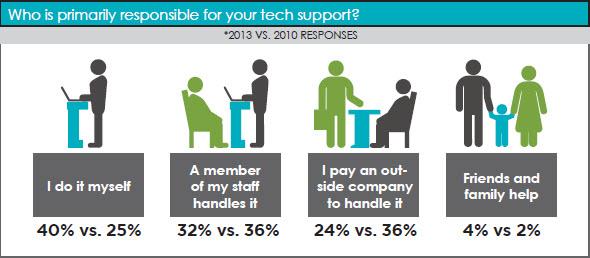There’s absolutely no avoiding it. With big companies like Salesforce and IBM acquiring stand-alone marketing automation companies, and recent VC funding news… the market is bullish on marketing automation. It’s a testament to the results that this technology brings to the top line. What once was reserved for enterprise, Russell 2000© Index-sized businesses is being adopted by small and medium-sized businesses. A feisty “Anything you can do, we can do better (and faster… and cheaper)” attitude inside a nimble, innovative genre of businesses is pushing the front lines of this technology bloom.
While medium- sized businesses (generally having 250 or fewer employees) have shown a steady increase in adoption of marketing technologies in the last several years, small businesses (generally having fewer than 50 employees) are finding huge successes with marketing automation technology , and are expected to contribute to the acceleration of adoption. Small business owners are finding that the results are definitely worth the costs.
The Economics of Marketing Automation
The reason behind this massive adoption and growth is simple: Presidents and CEOs are demanding proof that cash outlays produce positive return on investment, and marketing automation is delivering in spades. Advances in how data is used to understand business operations and finance are turning up some interesting – and important – new metrics. The term “lead to revenue” has crept into strategy planning discussions – so it’s natural that the fast-forward small business founders and CEOs are taking note and adjusting quickly.
Here’s an abridged, simple version of the economics behind it all.
How Leads Become Revenue
- Marketing creates a variety of campaigns that generate interest (often referred to as Demand Generation) in a product or service. This demand comes in the form of people engaging with some form of content – often on your website, in emails, at conferences and webinars – and a lead is born. Cost Per Lead (simple method) is calculated by total expense for a marketing campaign divided by the number of leads generated.
- Imagine that your have just spent $1,000 to generate 50 leads; the simple CPL is $20.
- Sales agrees to actively engage further with a certain portion of the people that show a quantifiable level of interest (often referred to as Sales-Ready Leads), and begin calling and other sales activities. A percentage of these leads go on to purchase a product or service. The total number of customers or sales created from the number of leads is a simple customer conversion rate. When two of those 50 leads result in a sale, the conversion rate is 4%.
- Average Sale Price (affectionately referred to as ASP) – the quick calculation here is the average revenue brought in from those two deals.
Here’s a simple ROI Calculator that will help you understand the economics of marketing automation. The calculator allows you to adjust the numbers you think you can gain, and gives you three before-and-after metrics you should be aware of. The numbers to remember: Return on Lead Dollars (the demand generation cousin to ROI); Customer Acquisition Cost; and the Lead to Customer Conversion rate.
The DIY Tech Boom for SMBs
Small businesses owners have a role that – more and more often – require them to be active experts at almost every facet of their business… including an understanding of the economics of leads. Technology is helping to scale operations in ways that allow them to protect profitability by keeping overhead low without throttling growth. Here are four reasons why small business owners are using marketing automation to power up the growth of their businesses.
1 – Simpler Technology
Most small business owners are not experts in Information Technology/Systems, but quickly become the go-to for their company IT needs. This chart, taken from a recent National Small Business Association Technology survey shows the growing role of small business owners in supporting technology. As owners of small businesses are taking on this role more, they are forced to adopt simple solutions to make sure they don’t end up with a resource-intensive boondoogle.
This image is courtesy of the National Small Business Association:
We’re all in the front row, witnessing the rise of a DIY marketing technology boom.
2 – Run. Sprint. Fast. (There’s no time for crawl-walk-run)
In business – especially small startups, speed doesn’t kill… the lack of it does. SMB owners are looking for technology that performs great, plugs in fast – and gets to work quickly on building revenue or increasing profits. There’s just not enough time, and certainly not enough employees – to wrangle with a long implementation process. The faster a technology can get to work for a business, the shorter the “time to value” becomes. Small businesses demand cloud-everything, plug-and-play SaaS, integrate-with-the-kitchen-sink, and show results in real time solutions. You should, too.
3 – Good, Great, Outstanding Customer Support Services
Great technology is only one side of the equation. No technology is bullet-proof; the people behind the product can make or break the adoption and ongoing success of marketing automation. Small business leaders know they need a life preserver for their staff for when things go wrong, and are looking more and more for dedicated support. If you’re in the market for marketing automation, make sure to ask the right questions to ensure you’ll getting great post-sale service without having to pay extra.
4 – The ROI Speaks for Itself
There’s no simpler explanation for the boom in marketing automation than the ROI small businesses are seeing. As owners and CEOs become savvier to the economics of marketing automation, they are comfortable taking a measured risk in on-boarding it. Just as businesses are demanding that marketing technology is simple, they won’t stand for ineffective solutions. Marketing automation is showing such huge strides in the market because it provides great ROI – and some have built-in tools to measure it.
